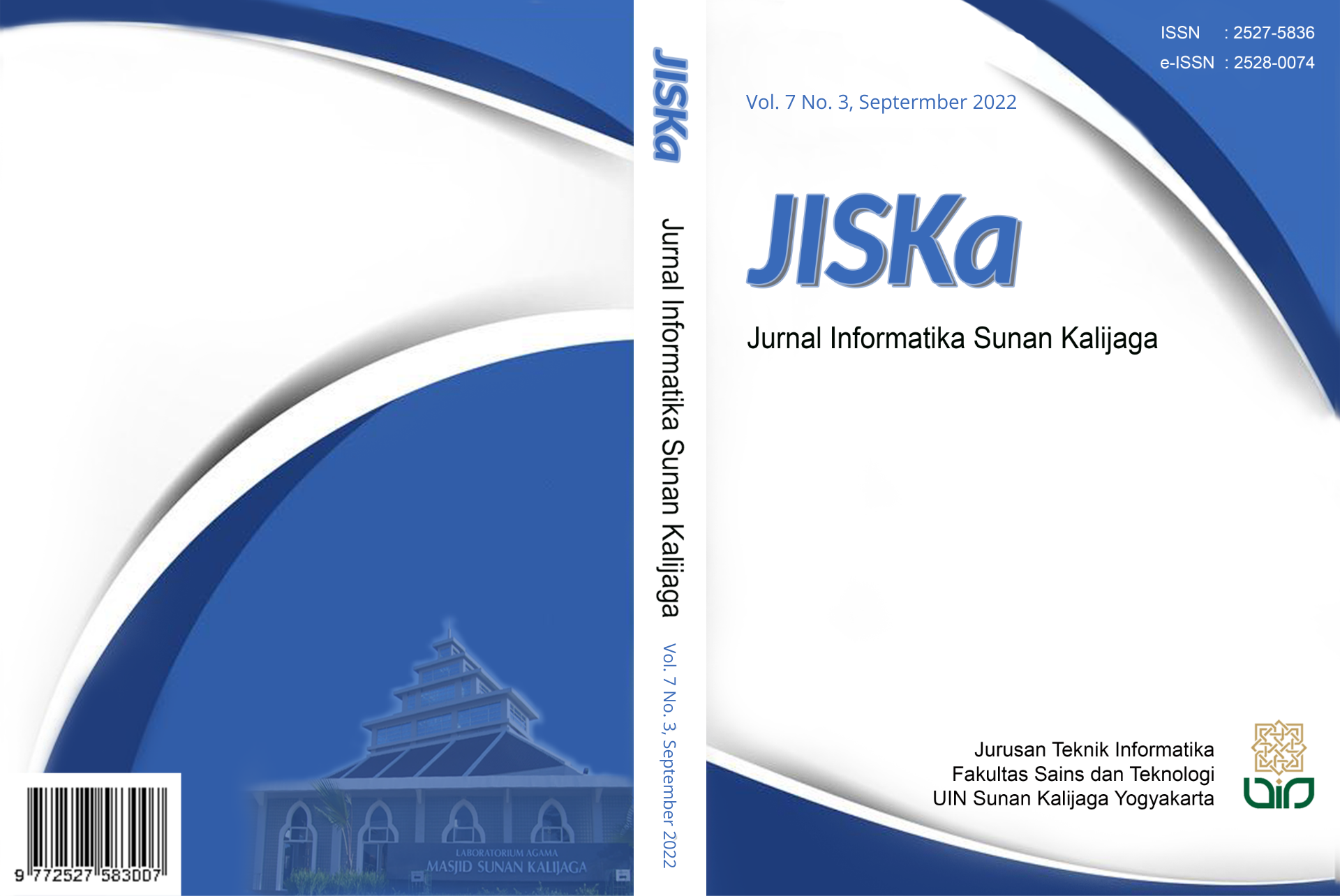Prototipe Alat Ukur Detak Jantung Menggunakan Sensor MAX30102 Berbasis Internet of Things (IoT) ESP8266 dan Blynk
DOI:
https://doi.org/10.14421/jiska.2022.7.3.163-176Keywords:
Heart Rate, IoT, Blynk, MAX30102, InfraredAbstract
The heart is an important organ of the human body. The heart functions to pump blood throughout the body. Health conditions can be seen in the condition of heart function. The heart’s function can be known through the beat when pumping blood. The manufacture of a heart rate device has been carried out using the PPG method. This tool uses the MAX30102 sensor as input. The measurement results are displayed on the smartphone. This tool can calculate the heart rate by sticking the surface of the fingertips for ten seconds. The light waves emitted by the sensor source will hit the surface of the finger. Changes in blood volume cause changes in light intensity according to what is received by the sensor. Based on the test results, the average standard deviation of this tool's heart rate measurement is 1.176. If considered the data from the pulse oximeter is correct, then this tool has an accuracy of 98.804%.
References
Ahmad, K., & Arfian, A. (2017). Rancang Bangun Alat Pengukur Detak Jantung Antarmuka Smartphone Melalui Bluetooth. Sinusoida, 19(2), 78–84.
Ambary, I. M., & Raharja, W. K. (2018). Purwarupa Alat Pendeteksi Detak Jantung Berbasis ATMEGA328. Jurnal Ilmiah Teknologi Dan Rekayasa, 23(1), 38–47. https://doi.org/10.35760/tr.2018.v23i1.2449
Anugara, A. (2021). Sistem Pengukuran Detak Jantung Secara RealTime pada Platform Internet of Things Menggunakan Metode Naive Bayes. Seminar Informatika Aplikatif Polinema, 58–63.
Anugrah, D. (2016). Rancang Bangun Pengukur Laju Detak Jantung Berbasis PLC Mikro. Elinvo (Electronics, Informatics, and Vocational Education), 1(3), 163–170. https://doi.org/10.21831/elinvo.v1i3.10857
Astutik, R. P., & Bakti, R. F. (2020). Sistem Monitoring Detak Jantung Berbasis LoRa. E-Link : Jurnal Teknik Elektro Dan Informatika, 15(1), 19. https://doi.org/10.30587/e-link.v15i1.1606
Brugarolas, R., Latif, T., Dieffenderfer, J., Walker, K., Yuschak, S., Sherman, B. L., Roberts, D. L., & Bozkurt, A. (2016). Wearable Heart Rate Sensor Systems for Wireless Canine Health Monitoring. IEEE Sensors Journal, 16(10), 3454–3464. https://doi.org/10.1109/JSEN.2015.2485210
Budi, D. B. S., Maulana, R., & Fitriyah, H. (2019). Sistem Deteksi Gejala Hipoksia Berdasarkan Saturasi Oksigen dan Detak Jantung Menggunakan Metode Fuzzy Berbasis Arduino. Journal of Information Technology Development and Computer Science, 3(2), 1925–1933.
Chooruang, K., & Mangkalakeeree, P. (2016). Wireless Heart Rate Monitoring System Using MQTT. Procedia Computer Science, 86(March), 160–163. https://doi.org/10.1016/j.procs.2016.05.045
Faesal, A. M., Santoso, I., & Sofwan, A. (2020). Desain Stetoskop untuk Deteksi Detak Jantung Menggunakan Sensor Suara dan Penghitungan BPM (Beat Per Minute) Menggunakan Arduino. Transmisi, 22(2), 44–50. https://doi.org/10.14710/transmisi.22.2.44-50
Hakim, F., & Nurwarsito, H. (2019). Sistem Pemantauan Detak Jantung dan Suhu Tubuh menggunakan Protokol Komunikasi MQTT. Jurnal Pengembangan Teknologi Informasi Dan Ilmu Komputer, 3(11), 10705–10711.
Harianto, B., Hidayat, A., Hulu, F. N., Telekomunikasi, P. T., Elektro, J. T., Medan, P. N., Utara, S., Elektronika, P. T., Elektro, J. T., Medan, P. N., Utara, S., & Oksigen, S. (2021). Analisis Penggunaan Sensor MAX30100 pada Sistem. Seminar Nasional Teknologi Sains Dan Humaniora (SemanTECH), 3(1), 238–245.
Hariri, R., Hakim, L., & Lestari, R. F. (2019). Sistem Monitoring Detak Jantung Menggunakan Sensor AD8232 Berbasis Internet of Things. Jurnal Telekomunikasi Dan Komputer, 9(3), 164. https://doi.org/10.22441/incomtech.v9i3.7075
Hindarto, Anshory, I., & Efiyanti, A. (2015). Aplikasi Pengukur Detak Jantung Menggunakan Sensor Pulsa. Prosiding Simposium Nasional Teknologi Terapan (SNTT) III, 1–5.
Hudhajanto, R. P., Mulyadi, I. H., & Sandi, A. A. (2022). Wearable Sensor Device berbentuk Face Shield untuk Memonitor Detak Jantung berbasis IoT. Journal of Applied Informatics and Computing, 6(1), 87–92. https://doi.org/10.30871/jaic.v6i1.4105
Irawan, Y., Fernando, Y., & Wahyuni, R. (2019). Detecting Heart Rate Using Pulse Sensor As Alternative Knowing Heart Condition. Journal of Applied Engineering and Technological Science (JAETS), 1(1), 30–42. https://doi.org/10.37385/jaets.v1i1.16
Isyanto, H., & Jaenudin, I. (2018). Monitoring Dua Parameter Data Medik Pasien (Suhu Tubuh Dan Detak Jantung) Berbasis Aruino Nirkabel. ELEKTUM, 15(1), 19–24. https://doi.org/10.24853/elektum.15.1.19-24
Karina, P., & Thohari, A. H. (2018). Perancangan Alat Pengukur Detak Jantung Menggunakan Pulse Sensor Berbasis Raspberry. Journal of Applied Informatics and Computing, 2(2), 57–61. https://doi.org/10.30871/jaic.v2i2.920
Kumar N., S., Kumar B., N., A., S., D., V., & Balaji N., M. (2017). Heart Rate Monitoring System using IoT. International Journal for Scientific Research & Development (IJSRD), 5(2), 853–854.
Kumari, W. M. P., & Victor, S. P. (2019). Heart Attack Detection & Heart Rate Monitoring Using IOT Techniques. Journal of Advanced Research in Dynamical and Control Systems, 11(06-Special Issue), 1471–1476.
Kusuma, R. S., Pamungkasty, M., Akbaruddin, F. S., & Fadlilah, U. (2018). Prototipe Alat Monitoring Kesehatan Jantung berbasis IoT. Emitor: Jurnal Teknik Elektro, 18(2), 59–63. https://doi.org/10.23917/emitor.v18i2.6353
Muhajirin, M., & Ashari, A. (2018). Perancangan Sistem Pengukur Detak Jantung Menggunakan Arduino Dengan Tampilan Personal Computer. Inspiration : Jurnal Teknologi Informasi Dan Komunikasi, 8(1). https://doi.org/10.35585/inspir.v8i2.2458
Noar, N. A. Z. M., & Kamal, M. M. (2017). The development of smart flood monitoring system using ultrasonic sensor with blynk applications. 2017 IEEE 4th International Conference on Smart Instrumentation, Measurement and Application (ICSIMA), 2017-Novem(November), 1–6. https://doi.org/10.1109/ICSIMA.2017.8312009
Nurdin, M., Aminah, N., Syahrir, Djamil, F., & Hamdani, M. F. (2015). Deteksi Denyut Jantung dengan Metode Sensor Pulsh Berbasis Ardiuno. Prosiding Seminar Nasional Teknik Elektro & Informatika SNTEI 2015, 201–206.
Prayitno, W. A., Muttaqin, A., & Syauqy, D. (2017). Sistem Monitoring Suhu, Kelembaban, dan Pengendali Penyiraman Tanaman Hidroponik menggunakan Blynk Android. Jurnal Pengembangan Teknologi Informasi Dan Ilmu Komputer, 1(4), 292–297.
Rachmat, H. H., & Ambaransari, D. R. (2018). Sistem Perekam Detak Jantung Berbasis Pulse Heart Rate Sensor pada Jari Tangan. ELKOMIKA: Jurnal Teknik Energi Elektrik, Teknik Telekomunikasi, & Teknik Elektronika, 6(3), 344. https://doi.org/10.26760/elkomika.v6i3.344
Rifa’i, A. F. (2016). Sistem Pendeteksi dan Monitoring Kebocoran Gas (Liquefied Petrolum Gas) Berbasis Internet of Things. JISKA (Jurnal Informatika Sunan Kalijaga), 1(1), 5–13. https://doi.org/10.14421/jiska.2016.11-02
Savitri, D. E. (2020). Gelang Pengukur Detak Jantung dan Suhu Tubuh Manusia Berbasis Internet of Things (IoT). In UIN Syarif Hidayatullah Jakarta. UIN Syarif Hidayatullah.
Serikul, P., Nakpong, N., & Nakjuatong, N. (2018). Smart Farm Monitoring via the Blynk IoT Platform : Case Study: Humidity Monitoring and Data Recording. 2018 16th International Conference on ICT and Knowledge Engineering (ICT&KE), 1–6. https://doi.org/10.1109/ICTKE.2018.8612441
Sipayung, F. H., Ramadhani, K. N., & Arifianto, A. (2018). Pengukuran Detak Jantung Menggunakan Metode Fotopletismograf. EProceedings of Engineering, 5(2), 3664–3670.
Sufri, S., & Aswardi, A. (2020). Alat Pendeteksi Detak Jantung dan Kesehatan Berbasis Arduino. JTEIN: Jurnal Teknik Elektro Indonesia, 1(2), 69–75. https://doi.org/10.24036/jtein.v1i2.31
Tamura, T., Maeda, Y., Sekine, M., & Yoshida, M. (2014). Wearable Photoplethysmographic Sensors—Past and Present. Electronics, 3(2), 282–302. https://doi.org/10.3390/electronics3020282
Wijaya, N. H., Fauzi, F. A., T.Helmy, E., Nguyen, P. T., & Atmoko, R. A. (2020). The Design of Heart Rate Detector and Body Temperature Measurement Device Using ATMega16. Journal of Robotics and Control (JRC), 1(2), 40–43. https://doi.org/10.18196/jrc.1209
Yassin, F. M., Sani, N. A., & Chin, S. N. (2019). Analysis of Heart Rate and Body Temperature from the Wireless Monitoring System Using Arduino. Journal of Physics: Conference Series, 1358(1), 012041. https://doi.org/10.1088/1742-6596/1358/1/012041
Yessianto, I., Setiawidayat, S., Effendy, D. U., & Einthoven, S. (2018). Perancangan Alat Monitoring Sinyal Jantung Menggunakan Arduino. Conference on Innovation and Application of Science and Technology (CIASTECH 2018), 601–608.
Yuhefizar, Y., Nasution, A., Putra, R., Asri, E., & Satria, D. (2019). Alat Monitoring Detak Jantung Untuk Pasien Beresiko Berbasis IoT Memanfaatkan Aplikasi OpenSID berbasis Web. Jurnal RESTI (Rekayasa Sistem Dan Teknologi Informasi), 3(2), 265–270. https://doi.org/10.29207/resti.v3i2.974
Yulian, R., & Suprianto, B. (2017). Rancang Bangun Photoplethysmograph (PPG) Tipe Gelang Tangan untuk Menghitung Detak Jantung. Jurnal Teknik Elektro, 6(3), 223–231.
Yulidarti, Y., & Hendri, H. (2020). Rancang Bangun Alat Pengukur Detak Jantung Menggunakan Komunikasi Wifi dengan Android. JTEV (Jurnal Teknik Elektro Dan Vokasional), 6(1), 277. https://doi.org/10.24036/jtev.v6i1.107976
Downloads
Published
How to Cite
Issue
Section
License
Copyright (c) 2022 Muthmainnah Muthmainnah, Deni Bako Tabriawan

This work is licensed under a Creative Commons Attribution-NonCommercial 4.0 International License.
Authors who publish with this journal agree to the following terms as stated in http://creativecommons.org/licenses/by-nc/4.0
a. Authors retain copyright and grant the journal right of first publication with the work simultaneously licensed under a Creative Commons Attribution License that allows others to share the work with an acknowledgement of the work's authorship and initial publication in this journal.
b. Authors are able to enter into separate, additional contractual arrangements for the non-exclusive distribution of the journal's published version of the work (e.g., post it to an institutional repository or publish it in a book), with an acknowledgement of its initial publication in this journal.
c. Authors are permitted and encouraged to post their work online (e.g., in institutional repositories or on their website) prior to and during the submission process, as it can lead to productive exchanges, as well as earlier and greater citation of published work.










